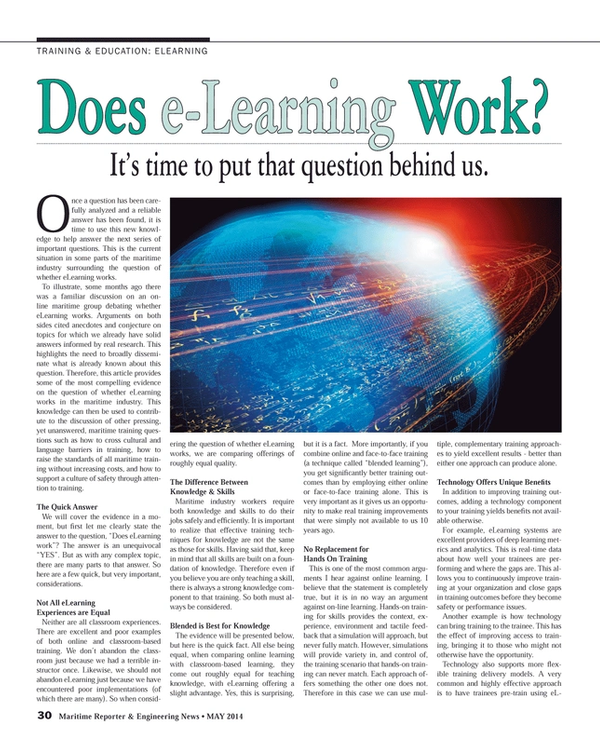
Does e-Learning Work?
It’s time to put that question behind us.
Once a question has been carefully analyzed and a reliable answer has been found, it is time to use this new knowledge to help answer the next series of important questions. This is the current situation in some parts of the maritime industry surrounding the question of whether eLearning works.
To illustrate, some months ago there was a familiar discussion on an online maritime group debating whether eLearning works. Arguments on both sides cited anecdotes and conjecture on topics for which we already have solid answers informed by real research. This highlights the need to broadly disseminate what is already known about this question. Therefore, this article provides some of the most compelling evidence on the question of whether eLearning works in the maritime industry. This knowledge can then be used to contribute to the discussion of other pressing, yet unanswered, maritime training questions such as how to cross cultural and language barriers in training, how to raise the standards of all maritime training without increasing costs, and how to support a culture of safety through attention to training.
The Quick Answer
We will cover the evidence in a moment, but first let me clearly state the answer to the question, “Does eLearning work”? The answer is an unequivocal “YES”. But as with any complex topic, there are many parts to that answer. So here are a few quick, but very important, considerations.
Not All eLearning Experiences are Equal
Neither are all classroom experiences. There are excellent and poor examples of both online and classroom-based training. We don’t abandon the classroom just because we had a terrible instructor once. Likewise, we should not abandon eLearning just because we have encountered poor implementations (of which there are many). So when considering the question of whether eLearning works, we are comparing offerings of roughly equal quality.
The Difference Between Knowledge & Skills
Maritime industry workers require both knowledge and skills to do their jobs safely and efficiently. It is important to realize that effective training techniques for knowledge are not the same as those for skills. Having said that, keep in mind that all skills are built on a foundation of knowledge. Therefore even if you believe you are only teaching a skill, there is always a strong knowledge component to that training. So both must always be considered.
Blended is Best for Knowledge
The evidence will be presented below, but here is the quick fact. All else being equal, when comparing online learning with classroom-based learning, they come out roughly equal for teaching knowledge, with eLearning offering a slight advantage. Yes, this is surprising, but it is a fact. More importantly, if you combine online and face-to-face training (a technique called “blended learning”), you get significantly better training outcomes than by employing either online or face-to-face training alone. This is very important as it gives us an opportunity to make real training improvements that were simply not available to us 10 years ago.
No Replacement for Hands On Training
This is one of the most common arguments I hear against online learning. I believe that the statement is completely true, but it is in no way an argument against on-line learning. Hands-on training for skills provides the context, experience, environment and tactile feedback that a simulation will approach, but never fully match. However, simulations will provide variety in, and control of, the training scenario that hands-on training can never match. Each approach offers something the other one does not. Therefore in this case we can use multiple, complementary training approaches to yield excellent results - better than either one approach can produce alone.
Technology Offers Unique Benefits
In addition to improving training outcomes, adding a technology component to your training yields benefits not available otherwise.
For example, eLearning systems are excellent providers of deep learning metrics and analytics. This is real-time data about how well your trainees are performing and where the gaps are. This allows you to continuously improve training at your organization and close gaps in training outcomes before they become safety or performance issues.
Another example is how technology can bring training to the trainee. This has the effect of improving access to training, bringing it to those who might not otherwise have the opportunity.
Technology also supports more flexible training delivery models. A very common and highly effective approach is to have trainees pre-train using eLearning, and then converge afterward at a central location for a shorter and more effective face-to-face experience.
These are some of the quick facts. Let’s look at the hard evidence now.
The Evidence
Arguably the best evidence of eLearning effectiveness is a report published in 2010 by the U.S. Department of Education (U.S. DOE). The report is entitled “Evaluation of Evidence-Based Practices in Online Learning, A Meta-Analysis and Review of Online Learning Studies”. The strength of this report comes from the fact that it is a meta-analysis. A meta-analysis looks at a large number of independent studies and draws a conclusion based on the strength of this large collection. This is powerful because the biases or flaws of individual studies are quickly filtered out of the collective response.
In the case of the U.S. DOE study, the meta-analysis looked at roughly 1,000 research studies, and then filtered them down to 45 which met rigorous design standards. From these studies the analysis came to several conclusions. Let’s look at some of the most notable quotes from this study:
Conclusion Number 1
Online Learning Outperforms
Face-to-Face Learning:
U.S. DOE Quote: “Students in online conditions performed modestly better, on average, than those learning the same material through traditional face-to-face instruction. Learning outcomes for students who engaged in online learning exceeded those of students receiving face-to-face instruction.”
The difference in effectiveness measured between online and face-to-face instruction was quite small, but it exists with the win going to online learning. From this we can say unequivocally that online learning most certainly does not produce inferior outcomes when compared to face-to-face instruction, as many incorrectly believe. In fairness, however, until I performed my own studies on eLearning effectiveness as a university researcher in the 1990s, I also assumed that eLearning would be inferior. I was wrong.
Conclusion Number 2
Blended Learning is Best:
U.S. DOE Quote: “Instruction combining online and face-to-face elements had a larger advantage relative to purely face-to-face instruction than did purely online instruction.“
The conclusion above indicates that when you use a combination of on-line and face-to-face training (referred to as “blended learning”), the learning outcomes are better than for either face-to-face or eLearning alone. This makes intuitive sense because each mode of learning has strengths the other one cannot offer. The implications are clear. If your goal is to provide the very best training possible, you should use a combined approach involving both face-to-face training and online learning.
Conclusion Number 3
Interaction with Peers and/or Instructors Improves Learning Outcomes:
U.S. DOE Quote: “Effect sizes [i.e. the improvement in learning outcomes] were larger for studies in which the online instruction was collaborative or instructor-directed than in those studies where online learners worked independently.”
This is a very important conclusion which cannot be stressed enough. One of the major advantages of online learning is its ability to connect people to one another, allowing them to learn from one another in a way that face-to-face training can’t. While it is indeed possible and effective for trainees to learn online independently, the best outcomes are achieved when we use technology to connect people to further facilitate the learning process.
Conclusion Number 4:
eLearning Works, Regardless
of the Subject Matter:
U.S. DOE Quote: “The effectiveness of online learning approaches appears quite broad across different content and learner types.”
eLearning has been around long enough and studied long enough that we can safely conclude that it is effective for all kinds of knowledge acquisition. There is nothing about maritime knowledge or maritime learners that makes the field immune to the benefits of eLearning. That is not to say that there are no hurdles to overcome in maritime eLearning - there are. For example, the availability of internet on-board, and the sophistication of vessel-based training both have slowed the adoption of eLearning in the industry. However, those obstacles are being (and have been) largely overcome by maritime-specific learning management systems (LMSs) and the industry is following suit by adopting eLearning methods. This study makes it clear that the benefits of eLearning are not domain-specific.
eLearning works. It has strengths which create an opportunity to do better than we do now. It is not a replacement for face to face or hands-on training, that is the wrong discussion to be having because we already know the answer. The real discussion is about how we apply the strengths and advantages that eLearning brings to an industry that is in desperate need of better (not more) training, more uniform training, and an elevated discussion on what we can do to achieve these.
The Author
Pek Murray Goldberg is CEO of Marine Learning Systems (www.MarineLS.com). An eLearning researcher and developer, his software has been used by 14 million people worldwide.
(As published in the May 2014 edition of Maritime Reporter & Engineering News - http://magazines.marinelink.com/Magazines/MaritimeReporter)
Read Does e-Learning Work? in Pdf, Flash or Html5 edition of May 2014 Maritime Reporter
Other stories from May 2014 issue
Content
- New Concept Eliminating Crude Oil Spill Spread page: 10
- BOS Provides 2-5% Fuel Savings page: 10
- Floating Production System Orders Outlook page: 12
- The Treatment of Foreign Seafarers page: 16
- Hydrodynamic Software Suites page: 19
- SEEMP: Potential Win-win for Commercial Vessels page: 20
- Ergonomic Controls Innovation for ECDIS, Bridge Controls page: 22
- To Litigate, or Arbitrate? That is the Question page: 24
- Experts Weigh Training Factor into Sewol Tragedy page: 26
- Does e-Learning Work? page: 30
- Elmer A. Sperry: Pioneer of Modern Naval Tech page: 32
- Aviator & Engineer: Lawrence Burst Sperry page: 38
- U.S. Navy's AGOR 27: R/V Neil Armstrong page: 40
- Classification Leaders Weigh in on Marine Propulsion page: 44
- Interview: Rich Hobbie, Water Quality Insurance Syndicate (WQIS) page: 48
- Mammoet: World’s Biggest Crawler Crane Installs Legs on Ship page: 52
- ALP Tugs Get Rolls-Royce Deck Equipment page: 52
- Traction and Control System for Tugboat Winches page: 53
- Townsville Opts for a Liebherr LHM 420 page: 53
- WASSP Goes Wireless with New Remote Mapping System page: 55
- Danelec’s 3G VDR page: 55
- ABB Energy Management System page: 55
- Transas Liquid Cargo Handling Simulator page: 55
- Color LCD Radar from SI-TEX page: 55
- Martek: Network-Connected ECDIS page: 55
- Vessel Optimization Data page: 55
- Lilaas L01 Control page: 56
- Northport Actisense Engine Monitoring Units page: 56
- MarineNav’s New Line of Displays page: 56
- Voyager Planning Station Adds AtoBviaC Distance Tables page: 56
- L-3 SAM for DanTysk Wind Project page: 56
- Navis Joystick System for New Yacht page: 56
- Ship-to-Turbine Oil Change System page: 57
- USN Orders Hoffer Flow Measurement Systems page: 57
- Phoenix Launches HDL-LED Series page: 57
- New Line of Safety Switches page: 57
- HAL Retrofits VDRs on Fleet page: 57
- New Steering System page: 57


